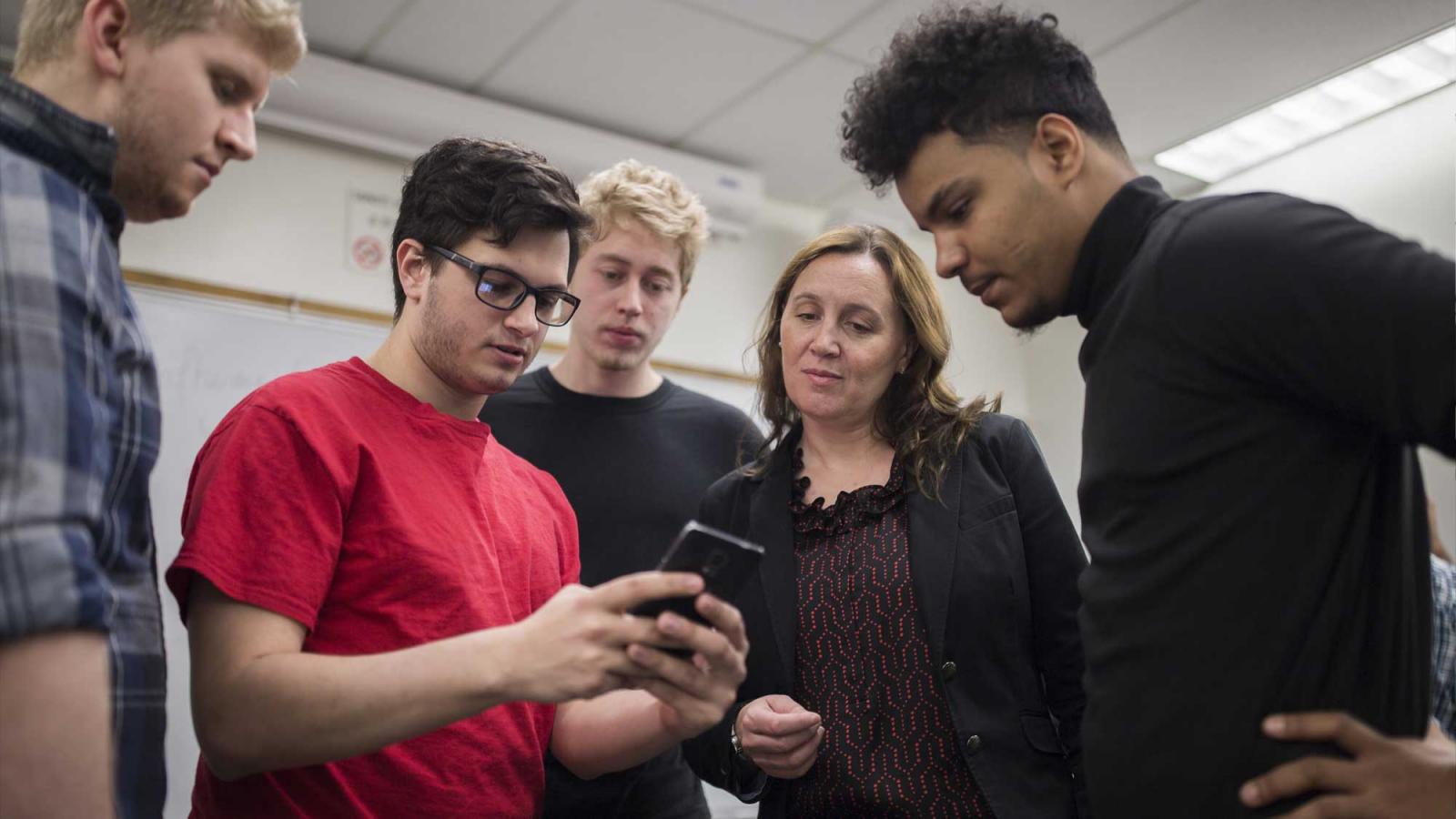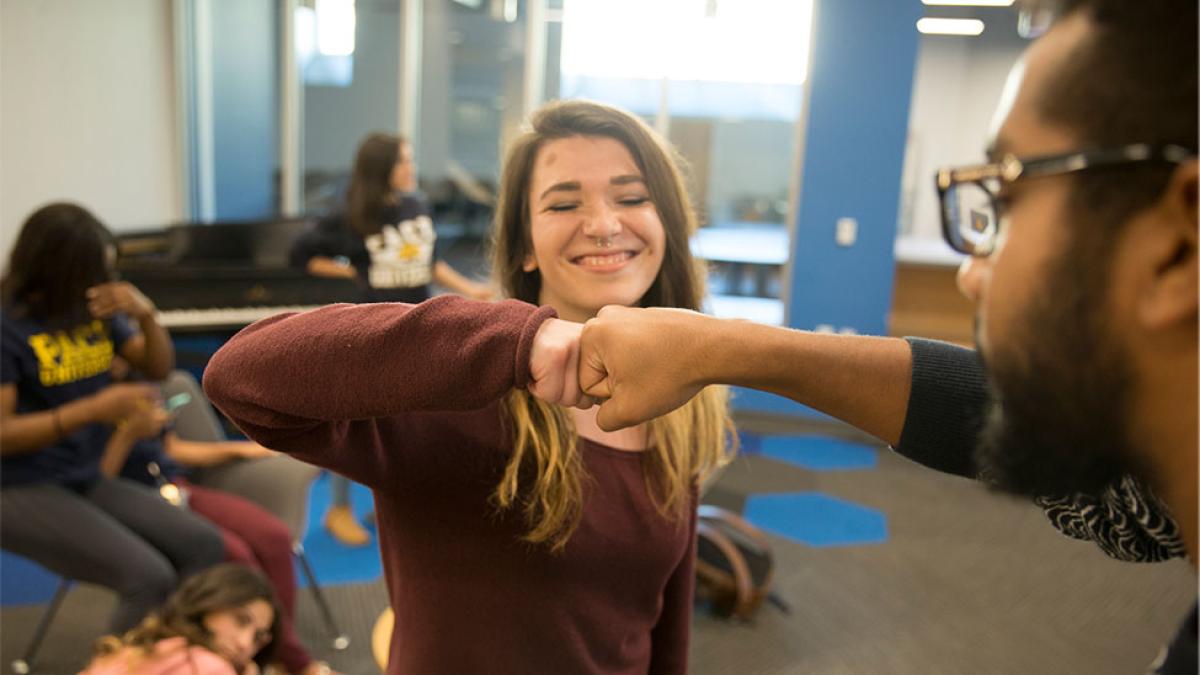As mental health becomes a global priority, expanding initiatives like mental health first aid can create lasting change across communities worldwide. Here's how we’re making it happen right here at Pace.
Fuel for Faculty Innovation

View the full issue of Pace Magazine.
With the inaugural class of Teaching Fellows, Pace University’s Faculty Center is building upon its strong foundation to become a major hub for interdisciplinary collaboration and innovation at Pace.
As the old adage goes, there’s no I in team. Similarly, as Pace’s faculty members are demonstrating through the newly restructured Faculty Center—there is no I in Pace faculty.
For two decades, Pace’s Faculty Center been an important component of the University’s DNA. Its mission has been to provide a place—physically and virtually—for professors to discuss teaching practices and general concerns across disciplines. Whereas a biology professor and a marketing professor may be focused on teaching completely different subject matter, their ultimate objective is quite similar: to share knowledge, innovate in their field, and provide an enriching classroom experience that can prepare each student for future success—whether it’s in the lab or the boardroom.
“As a faculty member, you have a role to play that’s beyond teaching academic content,” said Interim Associate Provost for Academic Affairs and Faculty Center Director Joan Walker, PhD. “Each of us has a subject matter expertise. And we teach that, but there’s a difference between—the way I like to frame it—is, do you teach biology to undergraduates, or do you teach undergraduates about biology? Which comes first, the subject matter, or the people?”
Walker, an expert in the learning sciences and the development of professional expertise, is leading the restructured Faculty Center alongside Faculty Center Assistant Director Ally Kimmel. And while they have maintained much of the Faculty Center’s traditional grounding, the pair have presided over the Center’s most significant change: the implementation of the inaugural class of Teaching Fellows.
What does this mean? Traditionally, each school at Pace has had a faculty representative, appointed to serve in an advisory capacity as a member of the Faculty Center Advisory Board. Now, under the new and improved structure, each school is appointed a Teaching Fellow. Each Teaching Fellow has decision-making control over a school-specific budget for faculty development priorities within their school, and is tasked with collaborating with their faculty colleagues to identify common goals and initiatives. Ultimately, Walker, Kimmel, and the Teaching Fellows are envisioning that this structural change will foster exciting University-wide initiatives such as boundary-pushing thematic programming. In turn, increased collaboration across schools will build a stronger, more united, and increasingly innovative faculty body.
"What if we think of ourselves as a University that's training the leaders that we need for the future—whether that's leaders in business, whether that's leaders in the environment, whether that's leaders in questions of racial justice or social justice,” said Kreitz. “I think we could be that institution."
“I’m really happy to be part of this group because it’s interdisciplinary,” said Seidenberg Teaching Fellow Christelle Scharff, PhD. “I’m learning a lot about what my colleagues are teaching in other areas, and what can be in fact integrated in more technical aspects of teaching. What I’m interested in, is to bring to Seidenberg more ideas for teaching at scale.”
Scharff, as part of her role as a Teaching Fellow, organized a virtual event featuring the Associate Computer Science Chair at Stanford University Mehran Sahami, which focused on the very issues she wants to foster at Seidenberg. Scharff’s event, “Scaling Introductory Programming Courses: Harnessing Both the Human and the Humane,” was beneficial not just for Seidenberg faculty members, but for all Pace faculty members interested in effective ways to teach complex topics to introductory, large-sized classes. The ethos of the Faculty Center has made these sorts of conversations—and cross discipline research and teaching possibilities—much more readily possible.
“The Faculty Center enables me to do what I tell my students to do, which is build a network of people who share your values, who you can trust their opinion,” said Lubin Teaching Fellow and Ivan Fox Professor and Scholar of Business Law Jessica Magaldi, JD. Magaldi is continuing her ongoing research focused on “revenge pornography” and the law, looking at the legal remedies women have when confronted with this particular type of malicious online harassment. By working with the Teaching Fellows, Magaldi has been able to get feedback on her own work from academics outside her particular area of study, enabling possibilities for further interdisciplinary perspective and opportunity to build upon her work; while simultaneously offering her own expertise to others.
“It’s a really nice cross-pollination opportunity,” said Magaldi.
Additional Teaching Fellows include Dyson STEM Teaching Fellow Marcy Kelly, PhD; Dyson Humanities Teaching Fellow, Kelley Kreitz, PhD; College of Health Professions Teaching Fellow Sophie Kaufman, DPS; School of Education Teaching Fellow Jennifer Pankowski, EdD; and Elisabeth Haub School of Law Teaching Fellow Emily Waldman, JD. Each Fellow has a specific focus for their individual school—ranging from improving outcomes in STEM Education for underrepresented students, to exploring ways to improve and enhance experiential learning at Pace. Yet all have also been able to draw upon their collective experience as Fellows to improve interdisciplinary communication, and expand the possibilities of teaching and scholarship at Pace.
“Realizing the amount of overlap, and just how we’re far more similar than we are different in a lot of our goals, has been fantastic,” said Pankowski.
All in all, Walker, Kimmel, and the Teaching Fellows are re-envisioning what it means to be a faculty member at the Pace—that it is not just a commitment to your individual research and teaching, but a commitment to a larger quest for shared innovation; a philosophy steeped in the ethos that a rising tide does indeed lift all boats.
"The Faculty Center enables me to do what I tell my students to do, which is build a network of people who share your values, who you can trust their opinion."
“What if we think of ourselves as a University that's training the leaders that we need for the future—whether that's leaders in business, whether that's leaders in the environment, whether that's leaders in questions of racial justice or social justice,” said Kreitz. “I think we could be that institution. But we won't be that institution, unless we find ways of coming together and talking to each other, celebrating the successes that we have in our individual courses and fields—but also the things and the values that we share and the soft skills that we're providing to students that come out of our curriculum as a whole.”
To learn more about the Faculty Center, the Teaching Fellows, and this year's virtual Institute on Teaching and Learning, visit the Faculty Center website.


